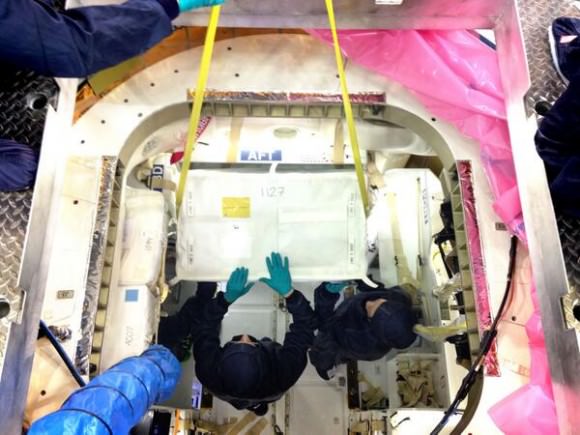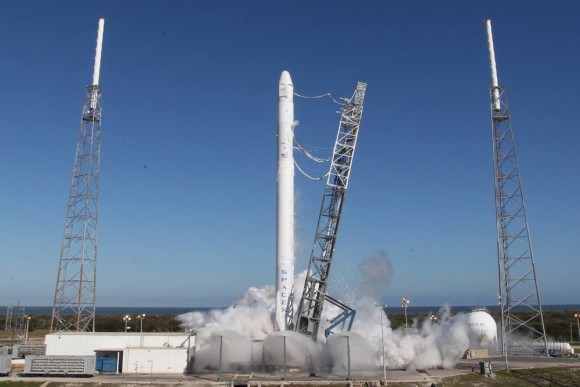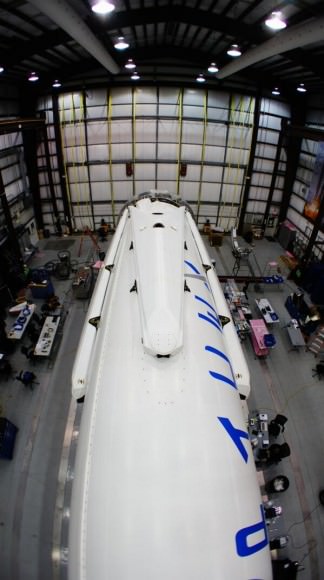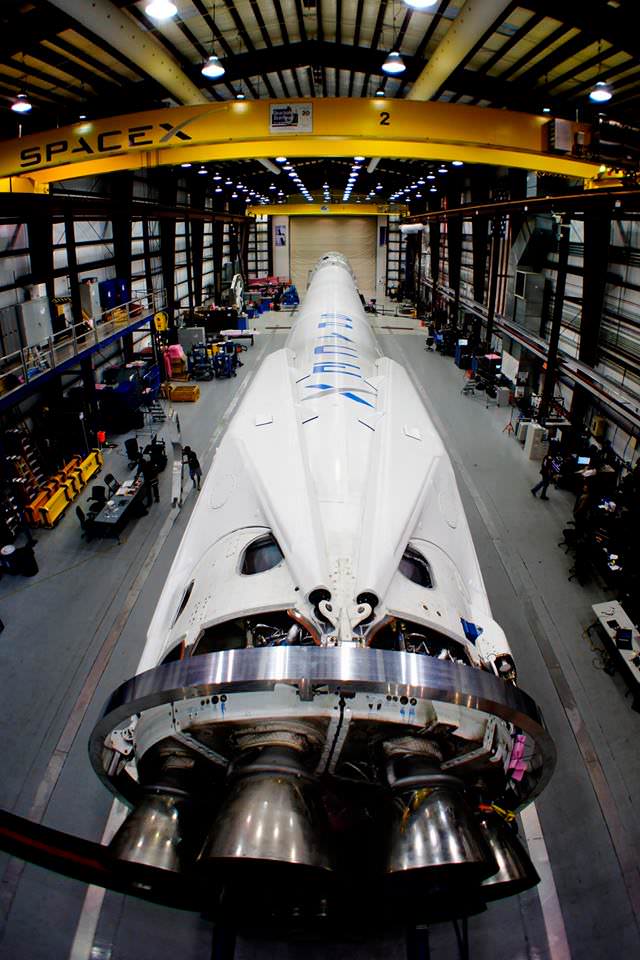SpaceX is nearly ready to Rock ‘n’ Roll with their first rocket sporting landing legs and slated to blast off this coming weekend carrying a commercial Dragon cargo freighter bound for the International Space Station (ISS).
Check out the Falcon 9 rockets gorgeous legs unveiled today by SpaceX in an eye popping new photo featured above.
The newly released image shows the private Falcon 9 positioned horizontally inside the Cape Canaveral processing hanger and looking up directly from the bottom of her legs and nine powerful first stage engines.
Following a brief static hotfire test this past weekend of all nine upgraded Merlin 1D engines powering the first stage of SpaceX’s next generation Falcon 9 rocket, the path is clear for Sunday’s (March 16) night time lift off at 4:41 a.m. EDT from Space Launch Complex 40 at Cape Canaveral Air Force Station in Florida.
This week, engineers working inside the hanger are loading the Dragon vessel with the final cargo items bound for the station that are time sensitive.

Altogether, this unmanned SpaceX CRS-3 mission will deliver over 5000 pounds of science experiments and essential gear, spare parts, crew provisions, food, clothing and supplies to the six person crews living and working aboard the ISS soaring in low Earth orbit under NASA’s Commercial Resupply Services (CRS) contract.

Dragon is carrying research cargo and equipment for over 150 science investigations, including 100 protein crystal experiments that will allow scientists to observe the growth of crystals in zero-G.
Conducted in the absence of gravity, these space experiments will help Earth bound researchers to potentially learn how to grow crystals of much larger sizes compared to here on Earth and afford scientists new insights into designing and developing new drugs and pesticides.
A batch of new student science experiments are also packed aboard and others will be returned at the end of the mission.
The attachment of landing legs to the first stage of SpaceX’s next-generation Falcon 9 rocket counts as a major first step towards the firm’s future goal of building a fully reusable rocket.
For this Falcon 9 flight, the rocket will sprout legs for a controlled soft landing in the Atlantic Ocean guided by SpaceX engineers.
“F9 will continue to land in the ocean until we prove precision control from hypersonic thru subsonic regimes,” says SpaceX CEO and founder Elon Musk.
It will be left to a future mission to accomplish a successful first stage touchdown by the landing legs on solid ground back at Cape Canaveral, Florida.
Much development works remains before a land landing will be attempted.
The Falcon will roll out from the hanger to Launch Pad 40 on Saturday, March 15.

SpaceX is under contract to NASA to deliver 20,000 kg (44,000 pounds) of cargo to the ISS during a dozen Dragon cargo spacecraft flights over the next few years at a cost of about $1.6 Billion.
To date SpaceX has completed two operational cargo resupply missions and a test flight to the station. The last flight dubbed CRS-2 blasted off a year ago on March 1, 2013 atop the initial version of the Falcon 9 rocket.

Following the scheduled March 16 launch and a series of orbit raising and course corrections over the next two days, Dragon will rendezvous and dock at the Earth facing port on the station’s Harmony module on March 18.
The Harmony port was recently vacated by the Orbital Sciences built Cygnus cargo spacecraft to make way for Dragon.
This extra powerful new version of the Falcon 9 dubbed v1.1 is powered by a cluster of nine of SpaceX’s new Merlin 1D engines that are about 50% more powerful compared to the standard Merlin 1C engines. The nine Merlin 1D engines 1.3 million pounds of thrust at sea level rises to 1.5 million pounds as the rocket climbs to orbit.
Therefore the upgraded Falcon 9 can boost a much heavier cargo load to the ISS, low Earth orbit, geostationary orbit and beyond.
Indeed Dragon is loaded with about double the cargo weight carried previously.
The Merlin 1D engines are arrayed in an octaweb layout for improved efficiency.

Stay tuned here for Ken’s continuing SpaceX, Orbital Sciences, commercial space, Orion, Chang’e-3, LADEE, Mars rover, MAVEN, MOM and more planetary and human spaceflight news. Learn more at Ken’s upcoming presentations at the NEAF astro/space convention on April 12/13.
And watch for Ken’s upcoming SpaceX launch coverage at Cape Canaveral & the Kennedy Space Center press site.


Ken: If you’re taking about the commercial cargo program, SpaceX actually conducted two test flights and two cargo runs. Only one of the test flights hooked up with the ISS though, so you could say that three flights went to the ISS if you wanted to change how you phrased that.
I’m sure there will one day be a statue memorializing Musk at the 1st manned landing site on Mars… Period. Amazing pioneer!
GO Space X! Go FALCON!
I can’t help but admire the aerodynamic shape of the landing leg fairings and wonder after the total design intent. It appears as though they were shaped so that the passing airflow would be compressed and injected into the exhaust plume? That would be well beyond simply protecting the landing leg mechanisms, but considering the source, I wouldn’t dismiss this possibility.